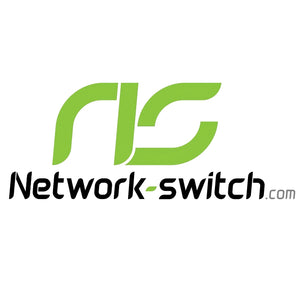Enterprise networking plays a vital role in virtually every organization. Cisco Catalyst series have been a part of network infrastructure for ever. This blog covers a detailed comparison between both of these series to help you decide.
Quick view of Cisco Catalyst 3850 and 9500 Series
First available in 2013, the Cisco Catalyst 3850 Series was once built for high-performance access-layer switching with built-in wireless controller capabilities. Suitable for medium to large enterprise networks, it provides advanced features such as StackWise-480 technology, PoE+ support for powering connected devices, and modular uplink options.
The Catalyst 9500 Series, launched in 2017, represents Cisco's next-generation fixed-core and aggregation switches. Based on the UADP 3.0 ASIC, the switches provide higher throughput, next-generation security features, and enhanced programmability to meet the needs of next-gen campus and data center networks.

10 Factors Comparison between 3850 and 9500 Series
| Factor | Catalyst 3850 | Catalyst 9500 |
| Port Density | 24/48 ports (Gigabit Ethernet) | 48 ports (10G/25G/40G/100G) |
| Uplink Options | 1G, 10G, 40G SFP+ modular uplinks | 10G, 25G, 40G, 100G fixed uplinks |
| Power Supply Options | 350W, 715W, 1100W AC, 440W DC | Dual AC power supplies, high availability |
| Stacking Technology | StackWise-480, up to 9 switches, 480 Gbps stacking bandwidth | No stacking, fixed-core design |
| Form Factor | 1U rack-mountable | 1U rack-mountable |
| Power over Ethernet (PoE) | Supports PoE+ (30W per port) | No PoE support |
| Software Options | Cisco IOS XE, limited automation | Cisco IOS XE, enhanced automation, integration with DNA Center |
| Performance | Switching capacity up to 92 Gbps, 480 Gbps stacking bandwidth | Switching capacity up to 1.6 Tbps, 1 Bpps forwarding rate |
| Management and Automation | Basic automation, supports Cisco Prime | Advanced automation, integration with Cisco DNA Center |
| Accessibility and Redundancy | Redundant power supplies and fans, StackWise redundancy | Redundant power supplies, fans, and advanced failover mechanisms |
Review and Satisfaction
Claims are subject to arbitration final and binding; Customers obtaining a refund will not be entitled to the benefits of this warranty.
The Catalyst 3850 definitely comes highly recommended from a reliability and cost standpoint in medium-sized networks. One prominent customer, a university, mentioned its PoE+ capability, which efficiently powered devices including wireless access points. That said, they stated that stacking functionality may have room for improvement with regard to larger deployments. In contrast, the Catalyst 9500 gets top marks in its categories for performance, especially at the kind of high-demand environments. A worldwide financial services company cited its ability to manage resource intense workloads, with solid security and effortless network automation.
Real-world case studies and examples
A retail chain went with the Catalyst 3850 in its nationwide stores with the advantage of stacking tech for management across its locations. The network stood still and was easily scalable as the company expanded. An example of this is the Catalyst 9500 that was used in large data centers to manage traffic between thousands of servers and to ensure high-speed connectivity. The 9500’s high capacity with redundant power supply was critical in maintaining uptime during peak operations. These products helped these companies address their network performance and scalability challenges.

Future Roadmap and Updates
Cisco continues to innovate and improve both the Catalyst 3850 and 9500 series. The Catalyst 3850 is an older model, but that also means its software is mature and still receives patches and updates. Cisco's future development efforts are to be focused on newer platform like the Catalyst 9300 and 9500 series that provides better performance and scalability.
Cisco has also pledged ongoing software innovations for the Catalyst 9500 series, such as better integration with Cisco DNA Center for easier automation and management. It is also worth noting that future updates will be dedicated to expanding the capacity of the 9500's hardware to support even the most demanding workloads as network traffic continues to evolve.
Where to Buy?
Network-switch is selling both the Cisco Catalyst 3850 series switches and 9500 series switches. com. We have a large inventory of Cisco hardware, including these models for new.
You can view and purchase models at network-switch.com and find Cisco products area. *Be sure to verify availability and pricing.
Conclusion
The Cisco Catalyst 3850 and 9500 both perform their respective functions well, but they each target different parts of the enterprise architecture. These features make the 3850 an ideal choice for organizations looking for high performance access-layer switch with PoE and stacking support at an affordable price point. On the other hand, the Catalyst 9500 supports mission-critical core, aggregation, and Internet edge architectures with high performance, high availability, exceptional scalability, and automation capabilities.
In the end, the decision between the two would depend on your organization’s unique needs, network size, and performance requirements. For the access layer if you need something robust and scalable, the Catalyst 3850 is solid. But if you are looking for the core or aggregation layer with more performant, fuller redundancy and advanced automation — the 9500 is the way to go.
Did this article help you understand network switches and how they work? Tell us on Facebook and LinkedIn . We’d love to hear from you!


 https://network-switch.com/pages/about-us
https://network-switch.com/pages/about-us